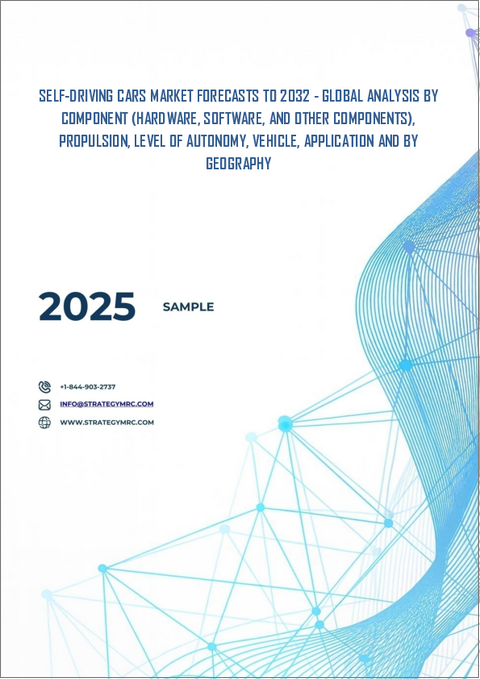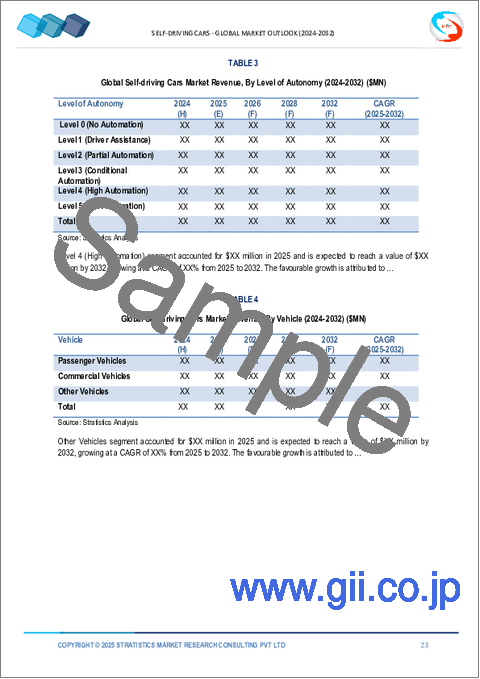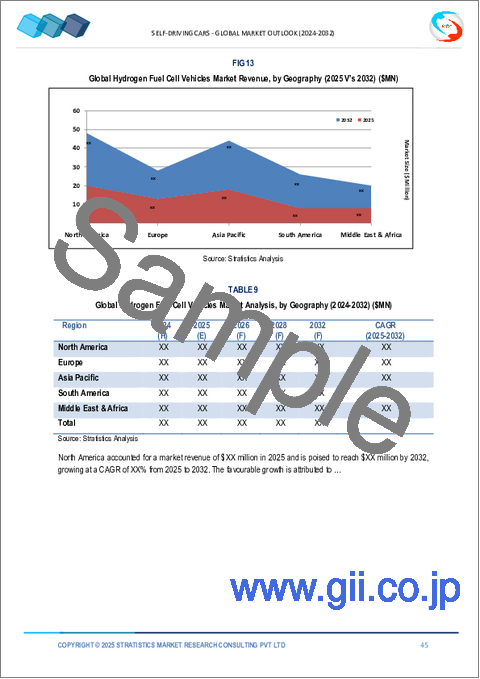|
|
市場調査レポート
商品コード
1662777
自動運転車市場の2030年までの予測: コンポーネント別、推進力別、自動化レベル別、車両別、用途別、地域別の世界分析Self-driving Cars Market Forecasts to 2030 - Global Analysis By Component (Hardware, Software, and Other Components), Propulsion, Level of Autonomy, Vehicle, Application and By Geography |
||||||
カスタマイズ可能
|
|||||||
| 自動運転車市場の2030年までの予測: コンポーネント別、推進力別、自動化レベル別、車両別、用途別、地域別の世界分析 |
|
出版日: 2025年02月02日
発行: Stratistics Market Research Consulting
ページ情報: 英文 200+ Pages
納期: 2~3営業日
|
全表示
- 概要
- 図表
- 目次
Stratistics MRCによると、世界の自動運転車市場は2024年に315億2,000万米ドルを占め、予測期間中のCAGRは15.9%で成長し、2030年には764億1,000万米ドルに達する見込みです。
自律走行車としても知られる自動運転車には、先進的センサ、カメラ、人工知能が搭載され、人間の介入なしにナビゲーションと操作を行っています。これらの車両は、先進的アルゴリズムに依存して周囲のデータを解釈し、安全で効率的な走行を確保するためにリアルタイムで意思決定を行っています。障害物を検知し、交通ルールを守り、ルートを動的に調整することができます。技術が進化を続けるなか、自動運転車は安全性を高め、交通渋滞を緩和し、すべての人にモビリティソリューションを提供することで、交通に革命をもたらすことが期待されています。
モビリティと利便性の向上に対する需要
自律走行車は、楽な移動を約束し、個人がハンドルを握る時間を取り戻すことを可能にします。これらの車両は、障害を持つ人々や運転できない人々のアクセシビリティを向上させることができます。さらに、自動運転車は交通の流れを最適化し、渋滞を緩和し、より効率的な輸送手段を提供することができます。自律走行車をライドシェアリングサービスに組み込むことで、利便性がさらに高まり、交通がより利用しやすく、使いやすいものになります。
データのセキュリティとプライバシーに関する懸念
自律走行車には、複数のセンサと通信ネットワークから収集される大量のデータが不可欠です。このデータはクルマの運行に欠かせないものだが、取り扱いを誤ったり侵害されたりした場合のリスクもあります。サイバーセキュリティの脅威や潜在的なデータの悪用は、自動運転技術に対する社会の信頼を損ないかねないです。堅牢なデータ保護対策を確保し、プライバシーに関する懸念に対処することは、自律走行車の普及に対する消費者の信頼と支持を得るために不可欠です。
高まる燃費効率
自律走行車の目標は、無駄なブレーキや加速を最小限に抑え、運転習慣を最適化し、効率的な速度を維持することです。全体的な燃料消費量と排出量を削減することで、これらの機能は燃費の向上に役立ちます。より環境に優しい輸送手段は、気候変動に対処しサステイナブルプラクティスを推進する国際的な取り組みと連動して推進されています。自動運転車の利用は、経済的・環境的メリットの両方から、燃費の重要性が増すにつれて増加すると予想されます。
雇用離職の懸念
運転業務の自動化は、トラック運送、タクシーサービス、公共輸送など、人間の運転手に依存している産業での雇用喪失につながる可能性があります。雇用への潜在的影響は、対処すべき倫理的・経済的問題を提起します。施策立案者や産業のリーダーたちは、再教育プログラムや、進化する自動車技術セグメントにおける新たな雇用機会を通じて、雇用離職の悪影響を緩和する方法を見つけなければならないです。
COVID-19の影響
COVID-19の大流行は、自動運転車市場にさまざまな影響を与えました。サプライチェーンの混乱と経済の不確実性が生産と開発を遅らせた1。しかし、パンデミックは、非接触型配送や必要不可欠な労働者の輸送など、自律走行車の利点も浮き彫りにしました。開発企業は、ソフトウェア開発とリモートテストに注力することで対応した1。全体として、パンデミックは、安全性と効率性の向上における自動運転技術の可能性を浮き彫りにしました。
予測期間中、ハードウェアセグメントが最大となる見込み
ハードウェアセグメントは、自動運転車の機能において重要な役割を担っているため、予測期間中に最大の市場シェアを占めると予想されます。先進的センサ、カメラ、LiDARシステムは、自律走行車が周囲の状況を正確に認識・解釈するための不可欠なコンポーネントです。技術が成熟するにつれて、ハードウェアの開発と生産への投資は増加すると予想され、市場における同セグメントの優位性が強化されます。
ハイブリッド車セグメントは予測期間中に最も高いCAGRが見込まれる
予測期間中、ハイブリッド車セグメントは、二重の動力源と効率の向上により、最も高い成長率を記録すると予測されます。ハイブリッド自動運転車は、電気と従来の燃料モードを切り替えることができるため、柔軟性が高く、航続距離も長くなります。この汎用性により、環境に優しく費用対効果の高い輸送手段を求める消費者にとって魅力的な選択肢となっています。持続可能性への注目の高まりとハイブリッドモデルの利用可能性の拡大は、このセグメントの急速な拡大を促進すると予想されます。
最大のシェアを占める地域
予測期間中、アジア太平洋は自律走行車技術とインフラへの大規模な投資により、最大の市場シェアを占めると予想されます。中国、日本、韓国のような国々は、自動運転車の研究、開発、配備をリードしています。この地域の堅調な自動車産業は、スマート交通を推進する政府のイニシアティブと相まって、市場の成長を支えています。さらに、アジア太平洋の高い人口密度と都市化は、効率的で革新的なモビリティソリューションに対する強い需要を生み出しています。
CAGRが最も高い地域
予測期間中、北米地域が最も高いCAGRを示すと予測されるが、これはその強力な技術基盤と支持的な規制環境による。米国とカナダには、自律走行車技術の進歩を推進する主要企業や自動車メーカーが多数存在します。この地域は官民パートナーシップやスマートインフラへの投資とともにイノベーションに注力しており、市場の成長を加速させています。ライドシェアリングや物流サービスにおける自動運転車の採用は、北米での市場拡大をさらに後押しします。
無料のカスタマイズ提供
本レポートをご購読の顧客には、以下の無料カスタマイズオプションのいずれかをご利用いただけます。
- 企業プロファイル
- 追加市場参入企業の包括的プロファイリング(3社まで)
- 主要企業のSWOT分析(3社まで)
- 地域セグメンテーション
- 顧客の関心に応じた主要国の市場推定・予測・CAGR(注:フィージビリティチェックによる)
- 競合ベンチマーキング
- 製品ポートフォリオ、地理的プレゼンス、戦略的提携による主要企業のベンチマーキング
目次
第1章 エグゼクティブサマリー
第2章 序文
- 概要
- ステークホルダー
- 調査範囲
- 調査手法
- データマイニング
- データ分析
- データ検証
- 調査アプローチ
- 調査情報源
- 1次調査情報源
- 2次調査情報源
- 前提条件
第3章 市場動向分析
- イントロダクション
- 促進要因
- 抑制要因
- 機会
- 脅威
- 用途分析
- 新興市場
- COVID-19の影響
第4章 ポーターのファイブフォース分析
- 供給企業の交渉力
- 買い手の交渉力
- 代替品の脅威
- 新規参入業者の脅威
- 競争企業間の敵対関係
第5章 世界の自動運転車市場:コンポーネント別
- イントロダクション
- ハードウェア
- LiDAR(光検出と測距)
- レーダーセンサ
- カメラ
- 超音波センサ
- AIベースのプロセッサとGPU
- GPSとナビゲーションシステム
- 5Gとクラウド接続
- ソフトウェア
- AIと機械学習アルゴリズム
- ADAS(先進運転支援システム)(ADAS)ソフトウェア
- 自動運転プラットフォーム
- クラウドベースのデータ処理とマッピング
- その他
第6章 世界の自動運転車市場:推進力別
- イントロダクション
- 内燃機関(ICE)車両
- ハイブリッド車
- 電気自動車
- 水素燃料電池自動車
- その他の推進力
第7章 世界の自動運転車市場:自動化レベル別
- イントロダクション
- レベル0(自動化なし)
- レベル1(運転支援)
- レベル2(部分自動化)
- レベル3(条件付き自動化)
- レベル4(先進的自動化)
- レベル5(完全自動化)
第8章 世界の自動運転車市場:車種別
- イントロダクション
- 乗用車
- 商用車
- その他
第9章 世界の自動運転車市場:用途別
- イントロダクション
- 配車サービスとロボットタクシー
- パーソナルモビリティ
- 公共輸送
- 貨物輸送と物流
- その他
第10章 世界の自動運転車市場:地域別
- イントロダクション
- 北米
- 米国
- カナダ
- メキシコ
- 欧州
- ドイツ
- 英国
- イタリア
- フランス
- スペイン
- その他の欧州
- アジア太平洋
- 日本
- 中国
- インド
- オーストラリア
- ニュージーランド
- 韓国
- その他のアジア太平洋
- 南米
- アルゼンチン
- ブラジル
- チリ
- その他の南米
- 中東・アフリカ
- サウジアラビア
- アラブ首長国連邦
- カタール
- 南アフリカ
- その他の中東・アフリカ
第11章 主要開発
- 契約、パートナーシップ、コラボレーション、合弁事業
- 買収と合併
- 新製品発売
- 事業拡大
- その他の主要戦略
第12章 企業プロファイリング
- Toyota Motor Corporation
- Tesla
- BYD co., ltd.
- Volkswagen Group
- Ford Motor
- General Motors
- Mercedes-Benz Group Ag
- BMW Group
- Hyundai Motor Group
- Nvidia Corporation
- Robert Bosch Gmbh
- Continental AG
- ZF friedrichshafen AG
- Denso Corporation
- Magna International Inc.
- Nxp Semiconductors
- Renault Group
- Aisin Corporation
- Hitachi Automotive
List of Tables
- Table 1 Global Self-driving Cars Market Outlook, By Region (2022-2030) ($MN)
- Table 2 Global Self-driving Cars Market Outlook, By Component (2022-2030) ($MN)
- Table 3 Global Self-driving Cars Market Outlook, By Hardware (2022-2030) ($MN)
- Table 4 Global Self-driving Cars Market Outlook, By LiDAR (Light Detection and Ranging) (2022-2030) ($MN)
- Table 5 Global Self-driving Cars Market Outlook, By Radar Sensors (2022-2030) ($MN)
- Table 6 Global Self-driving Cars Market Outlook, By Cameras (2022-2030) ($MN)
- Table 7 Global Self-driving Cars Market Outlook, By Ultrasonic Sensors (2022-2030) ($MN)
- Table 8 Global Self-driving Cars Market Outlook, By AI-Based Processors & GPUs (2022-2030) ($MN)
- Table 9 Global Self-driving Cars Market Outlook, By GPS & Navigation Systems (2022-2030) ($MN)
- Table 10 Global Self-driving Cars Market Outlook, By 5G & Cloud Connectivity (2022-2030) ($MN)
- Table 11 Global Self-driving Cars Market Outlook, By Software (2022-2030) ($MN)
- Table 12 Global Self-driving Cars Market Outlook, By AI & Machine Learning Algorithms (2022-2030) ($MN)
- Table 13 Global Self-driving Cars Market Outlook, By Advanced Driver Assistance Systems (ADAS) Software (2022-2030) ($MN)
- Table 14 Global Self-driving Cars Market Outlook, By Autonomous Driving Platforms (2022-2030) ($MN)
- Table 15 Global Self-driving Cars Market Outlook, By Cloud-Based Data Processing & Mapping (2022-2030) ($MN)
- Table 16 Global Self-driving Cars Market Outlook, By Other Components (2022-2030) ($MN)
- Table 17 Global Self-driving Cars Market Outlook, By Propulsion (2022-2030) ($MN)
- Table 18 Global Self-driving Cars Market Outlook, By Internal Combustion Engine (ICE) Vehicles (2022-2030) ($MN)
- Table 19 Global Self-driving Cars Market Outlook, By Hybrid Vehicles (2022-2030) ($MN)
- Table 20 Global Self-driving Cars Market Outlook, By Electric Vehicles (2022-2030) ($MN)
- Table 21 Global Self-driving Cars Market Outlook, By Hydrogen Fuel Cell Vehicles (2022-2030) ($MN)
- Table 22 Global Self-driving Cars Market Outlook, By Other Propulsions (2022-2030) ($MN)
- Table 23 Global Self-driving Cars Market Outlook, By Level of Autonomy (2022-2030) ($MN)
- Table 24 Global Self-driving Cars Market Outlook, By Level 0 (No Automation) (2022-2030) ($MN)
- Table 25 Global Self-driving Cars Market Outlook, By Level 1 (Driver Assistance) (2022-2030) ($MN)
- Table 26 Global Self-driving Cars Market Outlook, By Level 2 (Partial Automation) (2022-2030) ($MN)
- Table 27 Global Self-driving Cars Market Outlook, By Level 3 (Conditional Automation) (2022-2030) ($MN)
- Table 28 Global Self-driving Cars Market Outlook, By Level 4 (High Automation) (2022-2030) ($MN)
- Table 29 Global Self-driving Cars Market Outlook, By Level 5 (Full Automation) (2022-2030) ($MN)
- Table 30 Global Self-driving Cars Market Outlook, By Vehicle (2022-2030) ($MN)
- Table 31 Global Self-driving Cars Market Outlook, By Passenger Vehicles (2022-2030) ($MN)
- Table 32 Global Self-driving Cars Market Outlook, By Commercial Vehicles (2022-2030) ($MN)
- Table 33 Global Self-driving Cars Market Outlook, By Other Vehicles (2022-2030) ($MN)
- Table 34 Global Self-driving Cars Market Outlook, By Application (2022-2030) ($MN)
- Table 35 Global Self-driving Cars Market Outlook, By Ride-Hailing & Robo-Taxis (2022-2030) ($MN)
- Table 36 Global Self-driving Cars Market Outlook, By Personal Mobility (2022-2030) ($MN)
- Table 37 Global Self-driving Cars Market Outlook, By Public Transport (2022-2030) ($MN)
- Table 38 Global Self-driving Cars Market Outlook, By Freight & Logistics (2022-2030) ($MN)
- Table 39 Global Self-driving Cars Market Outlook, By Other Applications (2022-2030) ($MN)
Note: Tables for North America, Europe, APAC, South America, and Middle East & Africa Regions are also represented in the same manner as above.
According to Stratistics MRC, the Global Self-Driving Cars Market is accounted for $31.52 billion in 2024 and is expected to reach $76.41 billion by 2030 growing at a CAGR of 15.9% during the forecast period. Self-driving cars, also known as autonomous vehicles, are equipped with advanced sensors, cameras, and artificial intelligence to navigate and operate without human intervention. These vehicles rely on sophisticated algorithms to interpret data from their surroundings, making real-time decisions to ensure safe and efficient travel. They can detect obstacles, follow traffic rules, and adjust routes dynamically. As technology continues to evolve, self-driving cars promise to revolutionize transportation by enhancing safety, reducing traffic congestion, and providing mobility solutions for everyone.
Market Dynamics:
Driver:
Demand for enhanced mobility and convenience
Autonomous vehicles offer the promise of effortless travel, allowing individuals to reclaim time spent behind the wheel. These vehicles can improve accessibility for people with disabilities or those unable to drive. Furthermore, self-driving cars can optimize traffic flow, reduce congestion, and provide more efficient transportation options. The integration of autonomous vehicles into ride-sharing services adds another layer of convenience, making transportation more accessible and user-friendly.
Restraint:
Data security and privacy concerns
Large volumes of data gathered from several sensors and communication networks are essential to autonomous cars. This data is crucial for the car's operation but also poses risks if mishandled or breached. Cybersecurity threats and potential data misuse can undermine public trust in self-driving technology. Ensuring robust data protection measures and addressing privacy concerns are essential to gain consumer confidence and support for the widespread adoption of autonomous vehicles.
Opportunity:
Rising fuel efficiency
The goal of autonomous cars is to minimize needless braking and acceleration, optimize driving habits, and maintain efficient speeds. By lowering overall fuel consumption and emissions, these features help to increase fuel efficiency. Greener transportation options are being pushed in tandem with international initiatives to address climate change and advance sustainable practices. Self-driving car usage is anticipated to rise as fuel economy becomes more important, due to both economic and environmental advantages.
Threat:
Job displacement concerns
The automation of driving tasks could lead to job losses in industries reliant on human drivers, such as trucking, taxi services, and public transportation. The potential impact on employment raises ethical and economic questions that need to be addressed. Policymakers and industry leaders must find ways to mitigate the negative effects of job displacement through retraining programs and new job opportunities in the evolving automotive and technology sectors.
Covid-19 Impact
The COVID-19 pandemic had a mixed impact on the self-driving car market. Supply chain disruptions and economic uncertainties slowed down production and development1. However, the pandemic also highlighted the benefits of autonomous vehicles, such as contactless delivery and transportation for essential workers. Companies adapted by focusing on software development and remote testing1. Overall, the pandemic underscored the potential of self-driving technology in enhancing safety and efficiency.
The hardware segment is expected to be the largest during the forecast period
The hardware segment is expected to account for the largest market share during the forecast period, due to its critical role in the functioning of self-driving cars. Advanced sensors, cameras, and LiDAR systems are essential components that enable autonomous vehicles to perceive and interpret their surroundings accurately. As the technology matures, investments in hardware development and production are anticipated to grow, reinforcing the segment's dominance in the market.
The hybrid vehicles segment is expected to have the highest CAGR during the forecast period
Over the forecast period, the hybrid vehicles segment is predicted to witness the highest growth rate, due to their dual power sources and improved efficiency. Hybrid self-driving cars can switch between electric and conventional fuel modes, offering greater flexibility and extended range. This versatility makes them an attractive option for consumers seeking eco-friendly and cost-effective transportation solutions. The increasing focus on sustainability and the growing availability of hybrid models are expected to drive the segment's rapid expansion.
Region with largest share:
During the forecast period, Asia Pacific region is expected to hold the largest market share, due to its significant investments in autonomous vehicle technology and infrastructure. Countries like China, Japan, and South Korea are leading the way in research, development, and deployment of self-driving cars. The region's robust automotive industry, coupled with government initiatives to promote smart transportation, supports the market's growth. Additionally, the high population density and urbanization in Asia Pacific create a strong demand for efficient and innovative mobility solutions.
Region with highest CAGR:
Over the forecast period, the North America region is anticipated to exhibit the highest CAGR, owing to its strong technological base and supportive regulatory environment. The U.S. and Canada are home to many leading tech companies and automotive manufacturers driving advancements in autonomous vehicle technology. The region's focus on innovation, along with public-private partnerships and investment in smart infrastructure, accelerates market growth. The adoption of self-driving cars in ride-sharing and logistics services further boosts the market's expansion in North America.
Key players in the market
Some of the key players profiled in the Self-Driving Cars Market include Toyota Motor Corporation, Tesla, BYD co., ltd., Volkswagen Group, Ford Motor, General Motors, Mercedes-Benz Group Ag, BMW Group, Hyundai Motor Group, Nvidia Corporation, Robert Bosch Gmbh, Continental AG, ZF friedrichshafen AG, Denso Corporation, Magna International Inc., Nxp Semiconductors, Renault Group, Aisin Corporation, and Hitachi Automotive.
Key Developments:
In February 2025, TOYOTA GAZOO racing launches evolved GR Corolla in Japan. TOYOTA GAZOO Racing (TGR) has started accepting orders for its evolved GR Corolla, a model that leverages insights gained by competing in motorsports.
In December 2024, Volkswagen AG -with its brands Volkswagen Passenger Cars, Volkswagen Commercial Vehicles and Group Components and employee representatives have concluded a joint agreement entitled 'Zukunft Volkswagen' after intensive negotiations
Components Covered:
- Hardware
- Software
- Other Components
Propulsions Covered:
- Internal Combustion Engine (ICE) Vehicles
- Hybrid Vehicles
- Electric Vehicles
- Hydrogen Fuel Cell Vehicles
- Other Propulsions
Level of Autonomy Covered:
- Level 0 (No Automation)
- Level 1 (Driver Assistance)
- Level 2 (Partial Automation)
- Level 3 (Conditional Automation)
- Level 4 (High Automation)
- Level 5 (Full Automation)
Vehicles Covered:
- Passenger Vehicles
- Commercial Vehicles
- Other Vehicles
Applications Covered:
- Ride-Hailing & Robo-Taxis
- Personal Mobility
- Public Transport
- Freight & Logistics
- Other Applications
Regions Covered:
- North America
- US
- Canada
- Mexico
- Europe
- Germany
- UK
- Italy
- France
- Spain
- Rest of Europe
- Asia Pacific
- Japan
- China
- India
- Australia
- New Zealand
- South Korea
- Rest of Asia Pacific
- South America
- Argentina
- Brazil
- Chile
- Rest of South America
- Middle East & Africa
- Saudi Arabia
- UAE
- Qatar
- South Africa
- Rest of Middle East & Africa
What our report offers:
- Market share assessments for the regional and country-level segments
- Strategic recommendations for the new entrants
- Covers Market data for the years 2022, 2023, 2024, 2026, and 2030
- Market Trends (Drivers, Constraints, Opportunities, Threats, Challenges, Investment Opportunities, and recommendations)
- Strategic recommendations in key business segments based on the market estimations
- Competitive landscaping mapping the key common trends
- Company profiling with detailed strategies, financials, and recent developments
- Supply chain trends mapping the latest technological advancements
Free Customization Offerings:
All the customers of this report will be entitled to receive one of the following free customization options:
- Company Profiling
- Comprehensive profiling of additional market players (up to 3)
- SWOT Analysis of key players (up to 3)
- Regional Segmentation
- Market estimations, Forecasts and CAGR of any prominent country as per the client's interest (Note: Depends on feasibility check)
- Competitive Benchmarking
- Benchmarking of key players based on product portfolio, geographical presence, and strategic alliances
Table of Contents
1 Executive Summary
2 Preface
- 2.1 Abstract
- 2.2 Stake Holders
- 2.3 Research Scope
- 2.4 Research Methodology
- 2.4.1 Data Mining
- 2.4.2 Data Analysis
- 2.4.3 Data Validation
- 2.4.4 Research Approach
- 2.5 Research Sources
- 2.5.1 Primary Research Sources
- 2.5.2 Secondary Research Sources
- 2.5.3 Assumptions
3 Market Trend Analysis
- 3.1 Introduction
- 3.2 Drivers
- 3.3 Restraints
- 3.4 Opportunities
- 3.5 Threats
- 3.6 Application Analysis
- 3.7 Emerging Markets
- 3.8 Impact of Covid-19
4 Porters Five Force Analysis
- 4.1 Bargaining power of suppliers
- 4.2 Bargaining power of buyers
- 4.3 Threat of substitutes
- 4.4 Threat of new entrants
- 4.5 Competitive rivalry
5 Global Self-driving Cars Market, By Component
- 5.1 Introduction
- 5.2 Hardware
- 5.2.1 LiDAR (Light Detection and Ranging)
- 5.2.2 Radar Sensors
- 5.2.3 Cameras
- 5.2.4 Ultrasonic Sensors
- 5.2.5 AI-Based Processors & GPUs
- 5.2.6 GPS & Navigation Systems
- 5.2.7 5G & Cloud Connectivity
- 5.3 Software
- 5.3.1 AI & Machine Learning Algorithms
- 5.3.2 Advanced Driver Assistance Systems (ADAS) Software
- 5.3.3 Autonomous Driving Platforms
- 5.3.4 Cloud-Based Data Processing & Mapping
- 5.4 Other Components
6 Global Self-driving Cars Market, By Propulsion
- 6.1 Introduction
- 6.2 Internal Combustion Engine (ICE) Vehicles
- 6.3 Hybrid Vehicles
- 6.4 Electric Vehicles
- 6.5 Hydrogen Fuel Cell Vehicles
- 6.6 Other Propulsions
7 Global Self-driving Cars Market, By Level of Autonomy
- 7.1 Introduction
- 7.2 Level 0 (No Automation)
- 7.3 Level 1 (Driver Assistance)
- 7.4 Level 2 (Partial Automation)
- 7.5 Level 3 (Conditional Automation)
- 7.6 Level 4 (High Automation)
- 7.7 Level 5 (Full Automation)
8 Global Self-driving Cars Market, By Vehicle
- 8.1 Introduction
- 8.2 Passenger Vehicles
- 8.3 Commercial Vehicles
- 8.4 Other Vehicles
9 Global Self-driving Cars Market, By Application
- 9.1 Introduction
- 9.2 Ride-Hailing & Robo-Taxis
- 9.3 Personal Mobility
- 9.4 Public Transport
- 9.5 Freight & Logistics
- 9.6 Other Applications
10 Global Self-driving Cars Market, By Geography
- 10.1 Introduction
- 10.2 North America
- 10.2.1 US
- 10.2.2 Canada
- 10.2.3 Mexico
- 10.3 Europe
- 10.3.1 Germany
- 10.3.2 UK
- 10.3.3 Italy
- 10.3.4 France
- 10.3.5 Spain
- 10.3.6 Rest of Europe
- 10.4 Asia Pacific
- 10.4.1 Japan
- 10.4.2 China
- 10.4.3 India
- 10.4.4 Australia
- 10.4.5 New Zealand
- 10.4.6 South Korea
- 10.4.7 Rest of Asia Pacific
- 10.5 South America
- 10.5.1 Argentina
- 10.5.2 Brazil
- 10.5.3 Chile
- 10.5.4 Rest of South America
- 10.6 Middle East & Africa
- 10.6.1 Saudi Arabia
- 10.6.2 UAE
- 10.6.3 Qatar
- 10.6.4 South Africa
- 10.6.5 Rest of Middle East & Africa
11 Key Developments
- 11.1 Agreements, Partnerships, Collaborations and Joint Ventures
- 11.2 Acquisitions & Mergers
- 11.3 New Product Launch
- 11.4 Expansions
- 11.5 Other Key Strategies
12 Company Profiling
- 12.1 Toyota Motor Corporation
- 12.2 Tesla
- 12.3 BYD co., ltd.
- 12.4 Volkswagen Group
- 12.5 Ford Motor
- 12.6 General Motors
- 12.7 Mercedes-Benz Group Ag
- 12.8 BMW Group
- 12.9 Hyundai Motor Group
- 12.10 Nvidia Corporation
- 12.11 Robert Bosch Gmbh
- 12.12 Continental AG
- 12.13 ZF friedrichshafen AG
- 12.14 Denso Corporation
- 12.15 Magna International Inc.
- 12.16 Nxp Semiconductors
- 12.17 Renault Group
- 12.18 Aisin Corporation
- 12.19 Hitachi Automotive





